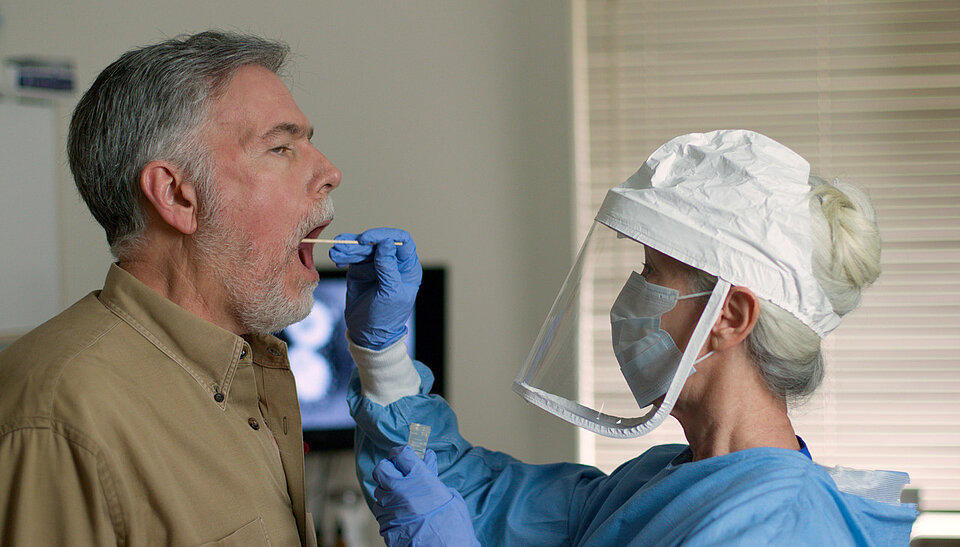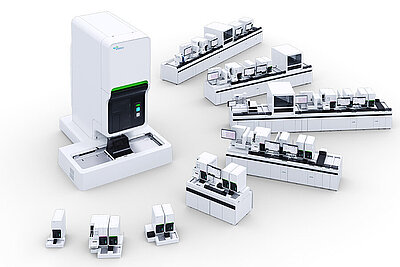COVID-19: How can routine diagnostic parameters support in clinical decision making?
The coronavirus pandemic has had a strong impact on all of our lives and will likely continue to influence us for some time. Health care professionals are facing remarkable challenges every day, being confronted with limited knowledge about the disease, its pathophysiology, and lack of clear treatment guidelines for patients.
New insights and discoveries are being published daily, with Sysmex learning day-by-day as well. We would like to support application / usability of this recent knowledge in context of COVID-19 disease management.
Explore clinically relevant findings and how Sysmex solutions can contribute.
Topics & Questions
Suspicion of infection?
Which quickly available lab results are suggestive of a SARS-CoV-2 infection?
Which quickly available lab results are suggestive of a SARS-CoV-2 infection?
Identification of COVID-19-positive patients upon hospital admission usually relies on RT-PCR tests, which can be time-consuming. However, clinicians need diagnostic information to make decisions during the first examination of a patient. An initial evaluation can be performed from the results of a complete blood count (CBC). In patients who test positive for COVID-19, white blood cells along with the main subpopulations (neutrophils, lymphocytes and monocytes) are reduced [3, 39], whereas haematological parameters that explore the activation status of cell populations, such as high-fluorescent lymphocytes (HFL) are elevated [1, 14].
At the same time, red blood cells, haemoglobin and haematocrit remain unaffected [3, 39]. This information might be indicative of a possible SARS-CoV-2 infection and can assist clinicians in the medical management at the time of admission.
Lab parameters quick guide
| Parameter | Kinetics of parameter | Reference |
| White blood cells ( WBC) | ↘ Decreased in COVID-19 positive patients | 3, 39 |
| Neutrophils (NEUT) | ↘ Decreased in COVID-19 positive patients | 3, 39 |
| Lymphocytes (LYMPH) | ↘ Decreased in COVID-19 positive patients | 3, 39 |
| Monocytes (MONO) | ↘ Decreased in COVID-19 positive patients | 3, 39 |
| High-fluorescent lymphocytes (HFLC) | ↗ Increased in COVID-19 patients | 1, 14 |
Which information can help to differentiate bacterial and viral infection?
Which information can help to differentiate bacterial and viral infection?
Host response against different pathogens generates distinct patterns of immune reactions, which can be identified by new haematological parameters that evaluate the activation status of immune cells. These patterns can be used to differentiate between a bacterial and a viral infection, assisting during the first contact with a febrile patient [4].
More details
What is the relevance of excluding haematological malignancies in patients suspected of SARS-CoV-2 infection?
What is the relevance of excluding haematological malignancies in patients suspected of SARS-CoV-2 infection?
In very early phases of disease, elevated levels of white blood cells (WBCs) in some cases cannot specifically be attributed to infection but might result from haematological malignancy. Like in different types of infections, symptoms in early SARS-CoV-2 infection are often unspecific. Before starting treatment, thorough clarification therefore comprises exclusion of a haematological malignancy as a cause of symptoms. State-of-the-art haematology analysers are able to exclude the presence of circulating blasts or neoplastic lymphocytes with a simple CBC-Diff.
Once a malignancy is excluded, new haematological parameters, such as extended inflammation parameters (EIP) that evaluate the activation status of lymphocytes and neutrophils, can be used to identify patterns of host immune response in infection [5].
Patient risk stratification
Why is risk stratification, especially in COVID-19, of very high importance?
Why is risk stratification, especially in COVID-19, of very high importance?
SARS-CoV-2 is a very new pathogen. However, the pandemic is evolving rapidly, and the condition of COVID-19 patients can change quickly during hospitalisation. Risk stratification therefore is among the most urgent questions of health care professionals. In that direction, lab parameters are explored as biomarkers of a severe course of the disease, with new articles published very frequently [6].
What are early indicators for a severe course of SARS-CoV-2 infection?
What are early indicators for a severe course of SARS-CoV-2 infection?
The infection course among patients is highly variable, but several laboratory parameters have been associated with severe and/or critical disease. Patients with severe disease showed a significantly lower platelet count, a shorter activated partial thromboplastin time (APTT), but higher D-dimer levels, higher fibrin degradation product (FDP) levels, higher fibrinogen levels and a prolonged prothrombin time [7 - 10]. In addition, elevated D-dimer levels of four times higher than normal, prolonged prothrombin time, and decreased platelet count (in decreasing order of importance) are indicators for a poor outcome of the disease and may help in stratifying patients who may need ICU admission and close monitoring during hospitalisation [11]. However, any underlying condition (e.g. liver disease) or medication (e.g. anticoagulants) which may alter the parameters should be accounted for regarding patient stratifying [11, 13].
Referring to the complete blood count (CBC), lymphopenia is observed in the majority of patients upon hospital admission but is more prominent in severe cases [8, 14, 36]. Similarly, neutrophilia is a characteristic of severe infections, but remains within normal ranges in healthy or non-severe cases [2, 15-16, 36]. Patients who develop severe disease also have a higher neutrophil to lymphocyte ratio (NLR) [15, 17, 36]. Finally, increased white blood cell (WBC) and neutrophil counts with concurrent lymphocytopenia can be used as early predictors for patients with high risk for ICU admission [12, 18-19, 37].
A meta-analysis of nine studies researching COVID-19 patients with nearly 400 with severe disease identified that the platelet count was significantly lower in patients with more severe COVID-19. Subgroup analysis comparing patients by survival noted lower platelet count correlated with mortality. Thrombocytopenia was also associated with over five-fold increased risk of severe COVID-19 illness. This suggests thrombocytopenia at the time of admission may be a prognosticator, but is not a consistent one [9, 12-13].
Despite these findings, it is still challenging for a single parameter to assess disease severity with high accuracy due to high individual variation and rapid change over time [6]. Correspondingly, studies have looked beyond single cell counts and have implemented scores to assess disease outcome, in which haematology parameters such as lymphocytes [20] and neutrophil to lymphocyte ratio [21] are used, among others.
Furthermore, the severity of COVID-19 infection is reflected in certain parameters from urinalysis:
Patients with severe disease progression or adverse outcome show a more frequent presence of urinary granular cylinders and renal tubular epithelial cells [22]. Furthermore, COVID-19-associated nephritis is a known symptom of the SARS-CoV-2 infection, leading to respiratory decompensation that requires ICU admission and ventilation. The risk for respiratory decompensation is elevated, if two out of the three conditions leucocyturia, albuminuria and haematuria are present [23]. Accurate, fast measurement of red blood cells (RBCs)/haemoglobin, white blood cells (WBCs), protein and albuminuria, test strip analysis [24], as well as urine particle detection can provide clinical decision support upon ICU admission.
Lab parameters quick guide
| Parameter | Kinetics of parameter | Reference |
| D-dimer (DD) | ↗ Increased levels in severe compared to milder cases of COVID-19. | 7, 8, 9,10 |
| Fibrin degradation product (FDP) | ↗ Increased levels in severe compared to milder cases of COVID-19, highly increased levels indicate a poor outcome of the patient | 7, 8, 9,10 |
| Fibrinogen (FBG) | ↗ Increased levels in hospitalized patients in the early to mid-term phase of the disease; ↘ Decreased in the critical phase (coagulopathy) | 7, 11, 42, 43, 44, 46, 49 |
| Factor VIII (FVIII) | ↗ Increased concentration in patients requiring ventilation and in patients with an increased risk of early-onset thrombosis. | 42 |
| Von Willebrand Factor (vWF ) | ↗ Increased concentration in patients with an increased risk of early-onset thrombosis specifically if ADAMTS13 levels are decreased. | 42, 44, 45, 46, 47 |
| A disintegrin and metalloproteinase with a thrombospondin type 1 motif, member 13 (ADAMTS13) | ↘ Decreased with increasing intensity of care of the patient | 42, 45, 47 |
| Plasminogen activator inhibitor-1 (PAI-I) | ↗ Increased in severe compared to milder cases of COVID-19 | 42, 47, 48 |
| Antithrombin (AT) | ↘ Normal to slightly decreased in patients with hypercoagulopathie due to its consumption to inhibit thrombin formed by activated coagulation. | 42 |
| Thrombin-Antithrombin complex (TAT) | ↗ Increased in severe compared to milder cases of COVID-19 | 42, 47 |
| Plasmin-α2-plasmin inhibitor complex (PIC, sometimes PAP) | ↗ Increased in patients with increased fibrinolysis. | 42 |
| Thrombomodulin (TM) | ↗ Increased. Highly increased levels may indicate a poor outcome of the patient. | 42, 44 |
| Prothrombin time (PT) | ↗ Increased time in severe cases, with a prolonged time indicating a poor outcome | 7, 42, 43, 44, 47 |
| White blood cells (WBC) | ↗ Increased levels in patients developing severe disease, and in patients admitted into the ICU | 2, 18, 19, 36, 37 |
| Neutrophils (NEUT) | ↗ Increased levels in patients developing severe disease, and in patients admitted into the ICU | 2, 15, 16, 36, 37 |
| Lymphocytes (LYMPH) | ↘ Decreased levels in patients developing severe disease, more prominent than during hospital admission, and in patients admitted into the ICU | 8, 14, 36, 37 |
| Neutrophil to lymphocyte ratio (NLR) | ↗ Increased levels in patients developing severe disease | 15, 17, 36 |
| Eosinophils (EO) | ↘ Decreased levels in patients developing severe diseases, and in patients admitted into the ICU | 2, 37 |
| Platelets (PLT) | ↘ Decreased levels in patients developing severe disease, that can also indicate a poor outcome | 7, 8, 9, 10, 11 |
| Antibody synthesising lymphocytes (AS-LYMP) | ↗ Increased absolute counts or as percentage within lymphocytes in patients developing severe disease | 2, 36, 40 |
| Reactive lymphocytes (RE-LYMP) | ↗ Increased as a percentage within lymphocytes in patients developing severe disease | 2, 36, 40 |
| Reactive monocytes (RE-MONO) | ↗ Increased levels in patients developing severe disease | 36, 40 |
| Neutrophil reactive intensity (NEUT-RI) | ↗ Increased levels in patients developing severe disease | 36 |
| Urinary granular cylinders (Cast* Hy.Cast* Path.Cast*) | ↗ Increased in severe cases | 22 |
| Renal tubular epithelial cells (WBC* LEU**) | ↗ Increased in severe cases | 22 |
| Leucocyturia (WBC* LEU**) | If present along with haematuria or albuminuria, risk for nephritis and ICU admission is elevated | 23 |
| Haematuria (RBC* Dysm.RBC*** BLD**) | If present along with leucocyturia or albuminuria, risk for nephritis and ICU admission is elevated | 23 |
| Albuminuria (ALB****) | If present along with haematuria or leucocyturia, risk for nephritis and ICU admission is elevated | 23 |
| Proteinuria (PRO****) | If present, along with haematuria, this parameter supports the early detection of renal impairment (e.g. AKI) in COVID-19 patients. | 41 |
* = Parameter on the UF-4000/UF-5000
** = Parameter on the UC-1000/UC-3500
*** = Flag on the UF-4000/UF-5000
**** = Parameter on the UC-1000/UC-3500, requiring Meditape 12S or Meditape 11A test strips, respectively.
What scores for SARS-CoV-2 infection are available and what is the benefit of using scores?
More than 140 models and scores have been developed by May 2020 with the aim to (a) identify risk groups for an unfavourable course of the disease within the general population, (b) identify COVID-19 positives amongst patients suspected of having an infection and (c) predict the course of infection of COVID-19 positive patients [35]. Depending on the type of model and score, the following factors are considered: patient demographics, comorbidities, lab tests and clinical examination results.
Use of single parameters to derive prognostic and predictive information can be inaccurate due to variations of biological markers over the time course of the infection and due to individual variations within the population. On the contrary, scores combining several parameters have the potential to balance such variations. Moreover, clinical decisions can be implemented faster when referring to one score value rather than interpreting several probably conflicting single parameter values.
A prognostic score to indicate early the need for ICU care and thus support patient management has been developed based on parameters from Sysmex XN-Series haematology analyser. Parameters reflecting patients’ immune cell activation such as antibody synthesising lymphocytes (AS-LYMP) and reactive monocytes (RE-MONO) are used, thus the score characterises the strength of immune response towards the infection. Based on parameter values measured within the first three days after presentation, the score potentially is able to predict the clinical severity of the infection within a two-week timeframe. Thus, the score may help to differentiate between patients who will recover without ventilation or deteriorate during this timeframe, or those who will need intensive care or have a fatal outcome. All required parameters are generated from a complete blood count with differential, the most common routinely requested baseline blood test globally [36]. The score is for research use only.
What is the relevance of diagnosing urinary tract infections (UTI) in suspected COVID-19 patients?
Although the frequency for bacterial and fungal coinfections seems to be low in early COVID-19 stages [25], urinary tract infection remains one of the most common infections and is also a result of long-term catheterisation, e.g. upon ICU admission. Furthermore, depending on their clinical condition, urinalysis to exclude pneumococcal and legionella infections is recommended for hospital admitted COVID-19 patients [26]. Urine particle analysis can exclude bacteriuria [27] and funguria [28] with high accuracy. As up to 80 % of suspected UTI cases turn out to be negative, the reliable exclusion of UTI within a minute allows for short-term decisions on and reduction of the prescription of antibiotics.
Is it possible to get an early prediction of COVID-19-related acute or chronic kidney disease?
Since acute kidney injury (AKI) increases the risk of developing chronic kidney disease (CKD) [29], COVID-19 patients that went through an AKI or showed proteinuria and haematuria should be monitored thoroughly following their COVID-19 infection. Changes in the albumin output, as well as the albumin-creatinine ratio can detect renal damages at the early stage of reversible, moderately increased albuminuria. This is supported by the detection of renal tubular epithelial cells (RTEC) and haematuria. Sensitive test strip analysis in combination with CMOS allows an accurate and cost-efficient analysis of a broad population [24].
Prognostic markers
Which markers are prognostic for patient survival?
Which markers are prognostic for patient survival?
Hospitalisation should be considered for COVID-19-positive patients who have significantly elevated D-dimers. D-dimers with > 2 μg/mL or four times higher values than normal are highly associated with poor disease progression and higher mortality. Those patients, in contrast to patients with slightly elevated levels, often require intensive care support [11].
Prothrombin time (PT) is prolonged in the non-survivors at admission but only rather modestly: 15.5 seconds [range 14.4–16.3 seconds] in non-survivors versus 13.6 seconds [13.0-14.3 seconds] in survivors (normal range:11.5−14.5 seconds). The PT is also mildly prolonged at admission in those who needed critical care support versus the non-ICU cohort (12.2 seconds [range 11.2–13.4] versus 10.7 seconds [range 9.8–12.1], respectively) [11-12].
Patients that succumbed to COVID-19 were presented more frequently with leucocytosis characterised by lymphopenia and neutrophilia than survivors [18-19, 30, 38], although it is important to note that these observations also correlate with increased disease severity and cannot be used as predictive markers for survival.
Furthermore, the platelet count is of relevance for disease outcome:
A meta-analysis of nine studies researching COVID-19 patients with nearly 400 with severe disease identified that the platelet count was significantly lower in patients with more severe COVID-19. Subgroup analysis comparing patients by survival noted lower platelet count correlated with mortality. Thrombocytopenia was also associated with over five-fold increased risk of severe COVID-19 illness. This suggests thrombocytopenia at the time of admission may be a prognosticator, but is not a consistent one [9, 12-13].
Lab parameters quick guide
| Parameter | Kinetics of parameter | Reference |
| D-dimer (DD) | ↗ Increased levels indicate the need for hospitalisation; more than a four-time increase is associated with higher mortality | 11 |
| Prothrombin time (PT) | ↗ Modest increased time in patients that did not survive | 11, 12 |
| Plasminogen (PLG) | ↘ Decreased levels in patients that did not survive | 43 |
| White blood cells (WBC) | ↗ Increased levels were more frequent in patients that did not survive | 18, 19, 30, 38 |
| Neutrophils (NEUT) | ↗ Increased levels in patients that did not survive | 18, 19, 30, 38 |
| Lymphocytes (LYMPH) | ↘ Decreased levels in patients that did not survive | 18, 19, 30, 38 |
| Platelets (PLT) | ↘ Decreased levels is correlated with higher mortality rates | 9, 12, 13 |
Therapy
Which therapeutic approaches are recommended to reduce mortality in COVID-19 patients?
Therapeutic approaches to reduce mortality
Several drugs have been investigated in COVID-19 patients with regards to improving survival. On 2 September, the WHO published a treatment guideline for the use of corticosteroids in COVID-19 patients based on the evidence from several randomised clinical trials. Systemic corticosteroids reduce 28-day mortality in patients with severe and critical COVID-19 [31]. Corticosteroids may reduce the inflammation in critical patients and therefore improve survival whereas in non-severe patients, corticosteroids may impair the immune response against the virus [32]. Therefore, the WHO strongly recommends not to administer these drugs to COVID-19 patients as they may increase the risk of death.
Which treatment is recommended to reduce the risk for thromboembolic events?
Thromboembolic events in COVID-19 infection
Thromboembolic events are a common complication of COVID-19 and mainly affect the venous, but also the arterial vasculature. All hospitalised patients should therefore receive low-molecular-weight heparin (LMWH) in a prophylactic dosage approved for prevention of venous thromboembolism (VTE). Observational studies suggest that a standard-dose LMWH prophylaxis is not sufficiently effective, particularly in intensive care patients, so that intensified anticoagulation, e.g. with an intermediate, semi-therapeutic LMWH dose should be considered. Alternatively, for example in the case of heparin intolerance or heparin-induced thrombocytopenia type II (HIT-II), the administration of danaparoid, fondaparinux, bivalirudin, or argatroban is possible [11, 33-34].
More details
References
Reference list
[1] OSMAN J et al. (2020): Rapid screening of COVID-19 patients using white blood cell scattergrams, a study on 381 patients. BJH; 190(5):718-722.
[2] YIP C et al. (2020): Temporal changes in immune blood cell parameters in COVID-19 infection and recovery from severe infection. BJH; 190(1):33-36.
[3] ZHANG C et al. (2020): Decreased “WBC*LYM” was observed in SARS-CoV-2-infected patients from a fever clinic in Wuhan. Clin Chem Lab Med 58(7):1152-1155.
[4] HENRIOT I et al. (2017): New parameters on the hematology analyzer XN-10 (SysmexTM) allow to distinguish childhood bacterial and viral infections. Int J Lab Hematol 39(1):14-20.
[5] White Paper: Characterisation reactive conditions & White blood cell functionality.
[6] KNIGHT S et al. (2020): Risk stratification of patients admitted to hospital with covid-19 using the ISARIC WHO Clinical Characterisation Protocol: development and validation of the 4C Mortality Score. BMJ370:m3339.
[7] HAN H et al. (2020): Prominent changes in blood coagulation of patients with SARS-CoV-2 infection. Clin Chem Lab Med. 58(7): 1116-1120.
[8] GUAN W et al. (2020): Clinical Characteristics of Coronavirus Disease 2019 in China. N Engl J Med. 382(18): 1708-1720.
[9] LIPPI G et al. (2020): Thrombocytopenia is associated with severe coronavirus disease 2019 (COVID-19) infections: a meta-analysis. Clin Chim Acta. 8981(20): 145-148.
[10] QU R et al. (2020): Platelet-to-lymphocyte ratio is associated with prognosis in patients with corona virus disease-19. J Med Virol. 92: 1533-41.
[11] THACHIL J et al. (2020): ISTH interim guidance on recognition and management of coagulopathy in COVID-19. J Thromb Haemost. 18: 1023–1026.
[12] HUANG C et al. (2020): Clinical features of patients infected with 2019 novel coronavirus in Wuhan, China. Lancet. 395 (10223): 497-506.
[13] TANG N et al. (2020): Abnormal coagulation parameters are associated with poor prognosis in patients with novel coronavirus pneumonia. J Thromb Haemost. 18(4): 844-847.
[14] WANG Z et al. (2020): High-fluorescent lymphocytes are increased in patients with COVID-19. BJH 190(2): e76-e78.
[15] QIN C et al. (2020): Dysregulation of Immune Response in Patients with Coronavirus 2019 (COVID-19) in Wuhan, China. Clin Infect Dis 71(15):762-768.
[16] HU L et al. (2020): Risk Factors Associated with Clinical Outcomes in 323 COVID-19 Hospitalized Patients in Wuhan, China. Clin Infect Dis; Online ahead of print
[17] YANG A et al. (2020): The diagnostic and predictive role of NLR, d-NLR and PLR in COVID-19 patients. Int Immunopharmacol 84:106504.
[18] WANG D et al. (2020): Clinical Characteristics of 138 Hospitalized Patients With 2019 Novel Coronavirus–Infected Pneumonia in Wuhan, China. JAMA 323(11):1061-1069.
[19] ZHOU F et al. (2020): Clinical course and risk factors for mortality of adult inpatients with COVID-19 in Wuhan, China: a retrospective cohort study. Lancet 395(10229):1054-1062.
[20] JI D et al. (2020): Prediction for Progression Risk in Patients With COVID-19 Pneumonia: The CALL Score. Clin Infect Dis 71(6):1393-1399.
[21] LIANG W et al. (2020): Development and Validation of a Clinical Risk Score to Predict the Occurrence of Critical Illness in Hospitalized Patients with COVID-19. JAMA Intern Med 180(8):1081-1089.
[22] Bonetti G et al. (2020): Urinalysis parameters for predicting severity in coronavirus disease 2019 (COVID-19). Clin Chem Lab Med 58(9): e163-e165.
[23] Gross O et al. (2020): COVID-19-associated nephritis: early warning for disease severity and complications? Lancet 395(10236): e87-e88.
[24] Delanghe JR et al. (2017): Sensitive albuminuria analysis using dye-binding based test strips. Clin Chim Acta 471: 107-112.
[25] Hughes S et al. (2020): Bacterial and fungal coinfection among hospitalized patients with COVID-19: a retrospective cohort study in a UK secondary-care setting. Clin Microbiol Infect 26(10):1395-1399.
[26] Hinweise zu Erkennung, Diagnostik und Therapie von Patienten mit COVID-19
[27] De Rosa R et al. (2018): Evaluation of the new Sysmex UF-5000 fluorescence flow cytometry analyser for ruling out bacterial urinary tract infection and for prediction of Gram-negative bacteria in urine cultures. Clin Chim Acta 484: 171-178.
[28] Song D et al. (2018): Selection of Unnecessary Urine Culture Specimens Using Sysmex UF-5000 Urine Flow Cytometer. Ann Clin Microbiol 21(4): 75-79.
[29] Selby N et al. (2020): COVID-19 and acute kidney injury in hospital: summary of NICE guidelines. BMJ 369: m1963.
[30] ZHANG B et al. (2020): Clinical characteristics of 82 cases of death from COVID-19. PLOS ONE. 15(7): e0235458.
[31] PRESCOTT H et al. (2020): Corticosteroids in COVID-19 ARDS, Evidence and Hope During the Pandemic. JAMA 324(13):1292-1295.
[32] The RECOVERY Collaborative Group (2020): Dexamethasone in Hospitalized Patients with Covid-19 — Preliminary Report. N Engl J Med. NEJMoa2021436.
[33] Watson H et al. (2012): Guidelines on the diagnosis and management of heparin-induced thrombocytopenia: second edition. British Journal of Haematology. 159 (5): 528–40. doi:10.1111/bjh.12059. PMID 23043677.
[34] Bakchoul T et al. (2012): Recent advances in the diagnosis and treatment of heparin-induced thrombocytopenia. Ther Adv Hematol. 3 (4): 237–51. doi:10.1177/2040620712443537. PMC 3627332. PMID 23606934.
[35] WYNANTS L et al. (2020): Prediction models for diagnosis and prognosis of COVID-19: systematic review and critical appraisal. BMJ 369:m1328
[36] LINSSEN J et al. (2020): A novel haemocytometric COVID-19 prognostic score developed and validated in an observational multicentre European hospital-based study. Elife 9:e63195.
[37] Mertoglu C et al. (2020): How do routine laboratory tests change in coronavirus disease 2019? Scand J Clin Lab Invest. 81(1):24-33
[38] Foy B et al. (2020): Association of Red Blood Cell Distribution Width With Mortality Risk in Hospitalized Adults With SARS-CoV-2 Infection. JAMA Netw Open 3(9):e2022058.
[39] Santotoribio J et al. (2020): Evaluation of Routine Blood Tests for Diagnosis of Suspected Coronavirus Disease 2019. Clin Lab. 66(9).
[40] Martens R et al. (2021): Hemocytometric characteristics of COVID-19 patients with and without cytokine Storm syndrome on the Sysmex XN-10 hematology analyzer. Clin Chem Lab Med 59(4): 783–793
[41] Sundaram S et al. (2021): Urine abnormalities predict acute kidney injury in COVID-19 patients: An analysis of 110 cases in Chennai, South India. Diabetes Metab Syndr 15(1):187-191.
[42] Von Meijenfeldt FA et al. (2021): Prothrombotic changes in patients with COVID-19 are associated with disease severity and mortality. Res Pract Thromb Haemost. 5(1):132-141.
[43] Juneja GK et al. (2021): Biomarkers of coagulation, endothelial function and fibrinolysis in critically‐ill patients with COVID‐19: A single‐centre prospective longitudinal study. J Thromb Haemost. 19(6):1546-1557.
[44] Vieceli Dalla Sega F et al. (2021): Time course of endothelial dysfunction markers and mortality in COVID-19 patients: A pilot study. Clin Transl Med. 11(3):e283.
[45] Mancini I et al. (2021): The ADAMTS13-von Willebrand factor axis in COVID-19 patients. J Thromb Haemost. 19(2):513-521.
[46] Rauch A et al. (2020): Coagulation biomarkers are independent predictors of increased oxygen requirements in COVID-19. J Thromb Haemost. 18(11):2942-2953.
[47] Blasi A et al. (2020): In vitro hypercoagulability and ongoing in vivo activation of coagulation and fibrinolysis in COVID-19 patients on anticoagulation. J Thromb Haemost. 18(10):2646-2653.
[48] Nougier C et al. (2020): Hypofibrinolytic state and high thrombin generation may play a major role in SARS-COV2 associated thrombosis. J Thromb Haemost. 18(9):2215-2219.
[49] Iba T et al. (2020): Coagulopathy in COVID-19. J Thromb Haemost. 18(9):2103-2109.









